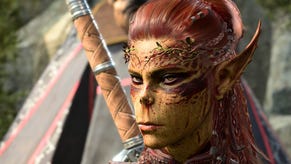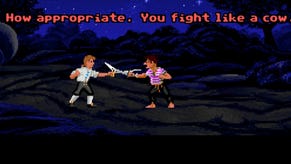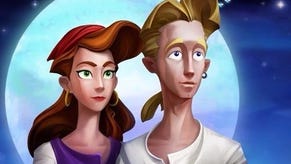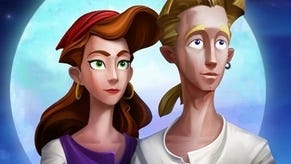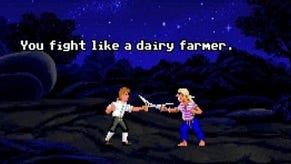Retrospective: The Curse of Monkey Island
Fresh bananas for the whole crew!
Some people are deliberately iconoclastic. Those people tend to be annoying idiots. Other people just have weird taste. Those people are also likely to be annoying idiots.
I like to think I'm sometimes in the second group of annoying idiots. So it is that I've spent my adult life being certain that The Curse Of Monkey Island - the third game in the legendary series - was rubbish.
To add insult to injury, I loved the fourth game. (Before we go on, assume that this article will contain spoilers on all of the first three Monkey Island games.)
Curse first came out in the UK in 1998, when I was 20. Which is deeply strange, since I was certain I was far younger when I played it. I'd have guessed about 15.
So that's almost 13 years of being certain it was the most overrated of the series, and that everyone else was talking out of their hat. This week I went back to play it, for the first time since, to see if I was right.
Spoiler warning: I wasn't right.
What I'm surprised to learn, in the very traditional point-and-clickery that sees Guybrush Threepwood once more attempting to rescue his love Elaine, and to defeat the ghost pirate LeChuck, is that it's perfectly decent. Perhaps even quite good.
In fact, it's better than the first game.

Heck, if I'm going to go wild, I may as well throw it all in. With LucasArts having recently remade the first two games with new graphics, and full voice acting, it's been fascinating to go back to two of PC gaming's most treasured relics and discover that The Secret Of Monkey Island isn't actually all that brilliant.
It's a short, not particularly funny game, with no narrative worth worrying about and a few highlights that have overridden people's memories of the complete experience. Monkey Island 2 stands up far better and is genuinely very funny. And of course it has that ending.
It turns out that Guybrush and LeChuck are in fact children, and brothers, and at a fairground. This ending was crazy-bonkers. It was so crazy, in fact, that when new project leads Jonathan Ackley and Larry Aher (who had worked on Full Throttle) took over from the departed Ron Gilbert, they just sort of pretended it hadn't happened.
There's a nod to it at the beginning, Guybrush floating helplessly on a funfair dodgem, and an extended return to the Big Whoop theme park on Monkey Island at the end.
There's even an ambiguous allusion to it with Guybrush getting turned into a child by LeChuck's magic. But otherwise, Gilbert, Schafer and Grossman's lunatic finale for the second game was sensibly coughed away.
Quite a lot had changed since the last Monkey outing, with a significant six years having passed. LucasArts was moving into 3D, Grim Fandango was only a year away (and wantonly plugged during the game), and this was to be the last of the company's games to be made in a hugely modified SCUMM engine.
Mechanically, Monkey 3 was pretty much identical to Full Throttle, with a verb coin appearing when the mouse is held down, offering either 'look', 'use' or 'talk to'. Long gone were the nine verbs or six cursors of Sam & Max.
But few corners were cut when it came to cramming in jokes. In fact, Curse is far more joke-dense than either of the previous games. Most locations are packed with objects to look at and plenty of unnecessary actions eliciting uniquely written gags.
The graphics were also dramatically changed, using very simplistic cartoons. This meant there was far more cartoon logic. Often cartoon graphics survive time far better than anything the nineties tried to put in 3D, with 1993's Day Of The Tentacle still looking wondrous today.
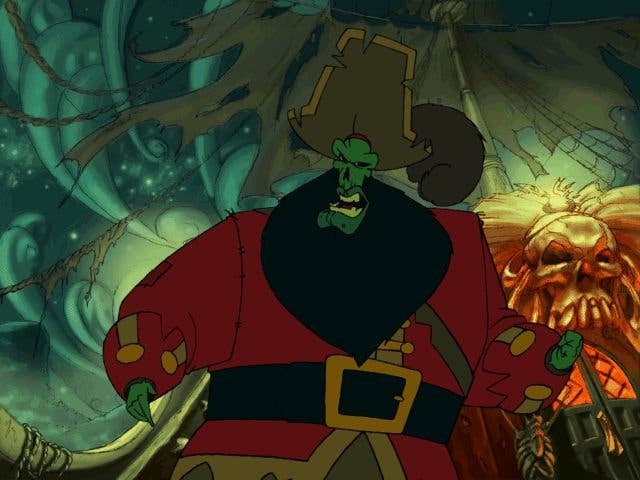
However, Curse's artists seem to have cut so many corners that the modern day perspective is mixed. There are many more minor characters who appear barely sketched, with very crude animations, seeming to possess far less charm than the exquisitely carefully constructed pixel creations from the first two games.
It seems that The Curse Of Monkey Island was a game trapped between two times. It was the last hurrah of LucasArts' 2D adventuring, trying to fit into a world that was stuffing its PCs with 3dfx cards.
In so many ways the game feels like a relic. Not least because it spends so much of its time referencing two games from 1990 and 91.
With series regulars like the Voodoo Lady and Stan appearing, now it seems daft that the game works so hard to reintroduce them. But with over half a decade having passed, a good proportion of the potential audience wouldn't have had any idea who they were. Plus a lot of the references were starting to feel dated back then and now seem positively archaic.
During my eighties childhood, about 70 per cent of the programmes I watched included quicksand at some point. To misquote comedian Adam Carolla, until the age of 10 I was certain I was either going to die by falling in quicksand or by being eaten by cannibals who would first make me their god.
Now, outside of madman Bear Grills' on-screen suicide attempts, there's not a drip of quicksand to be found. And worrying about being eaten by cannibals is perhaps considered culturally insensitive.



